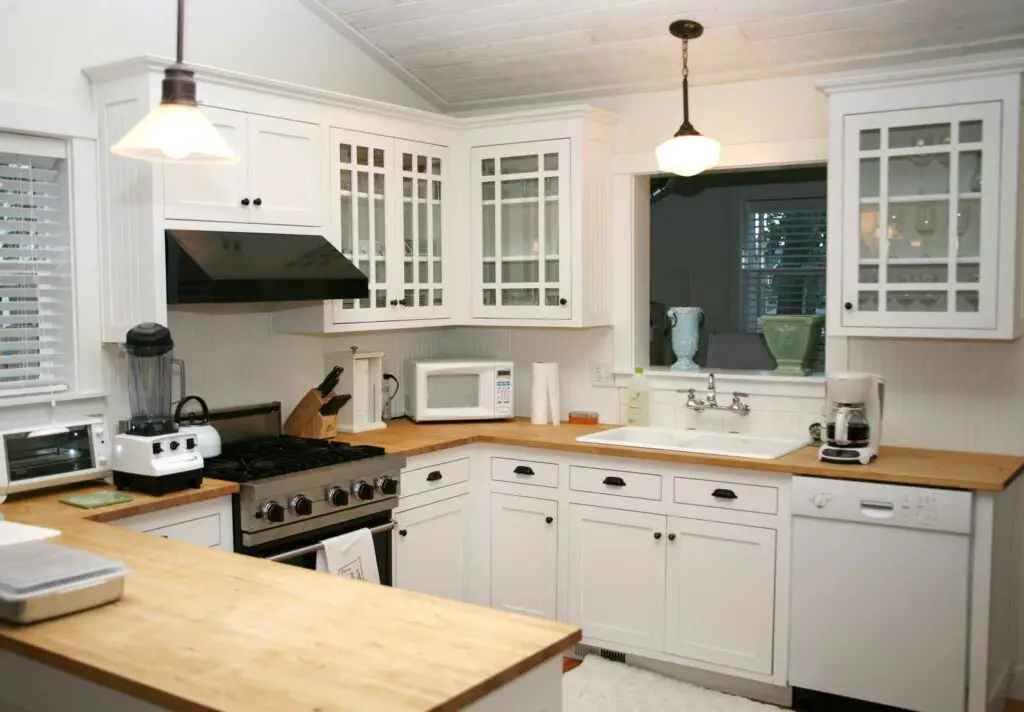A kitchen with butcher block countertops exudes warmth and comfort. Choosing the perfect backsplash for your butcher block counters can enhance this cozy ambiance and complete your kitchen’s look. Backsplashes not only add aesthetic appeal but also protect your walls from stains and splatters, making them a functional and stylish addition to any kitchen.
When selecting a backsplash for your butcher block countertops, consider the materials that will best complement your counter’s style and color. Popular options include subway tiles, beadboard, and even painted brick. Each option offers its own unique attributes and can enhance your kitchen’s overall design. Ensure you choose a material that is easy to clean and maintain, as this will save you time and effort in the long run.
As you move forward in the decision-making process, remember to take proper installation techniques into account. A well-installed backsplash will ensure it remains both durable and eye-catching for years to come. By weighing the benefits and drawbacks of different materials, you can create a cohesive and inviting space that showcases your beautiful butcher block countertops.
- Consider various backsplash materials to complement your butcher block countertop
- Keep in mind the practical aspects of cleanliness and maintenance when choosing a backsplash
- Proper installation is essential for a durable and visually pleasing backsplash
Backsplash Material Options
When it comes to choosing a backsplash for your butcher block countertop, there are several materials to consider. In this section, we’ll explore five popular options: Tile, Stone, Stainless Steel, Glass, and Wood.
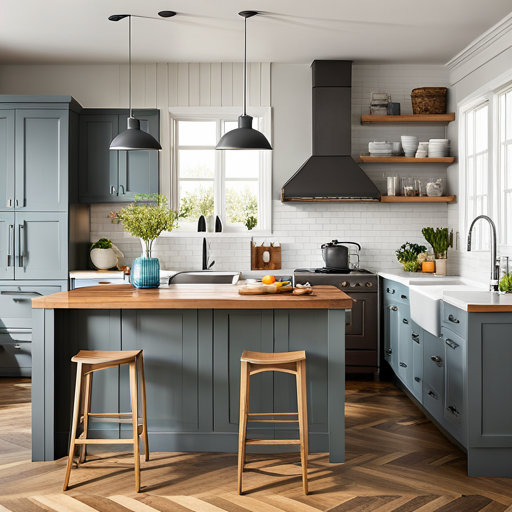
Tile
Tiles are a versatile and affordable choice for a backsplash. They come in various materials like ceramic, porcelain, and glass. Depending on your preference, you can select tiles that complement the color and texture of your butcher block countertop. With tiles, you can create a classic white subway tile design or choose a unique pattern to make a statement.
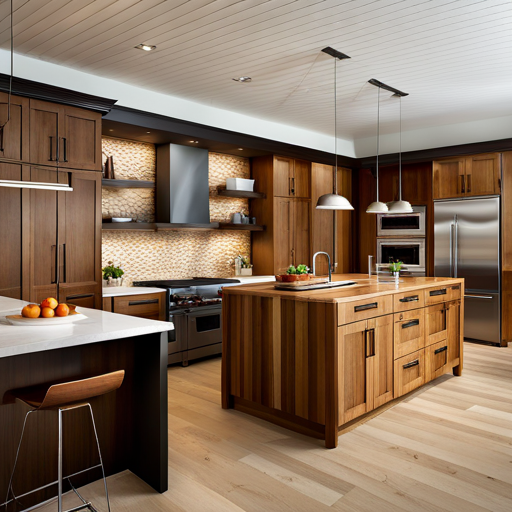
Stone
Natural stone, such as granite, marble, and travertine, creates a high-end and timeless look for your backsplash. With their durability and natural beauty, stone backsplashes are both practical and visually appealing. Keep in mind that stone may require more maintenance, such as sealing, to protect them from staining and maintain their original appearance.
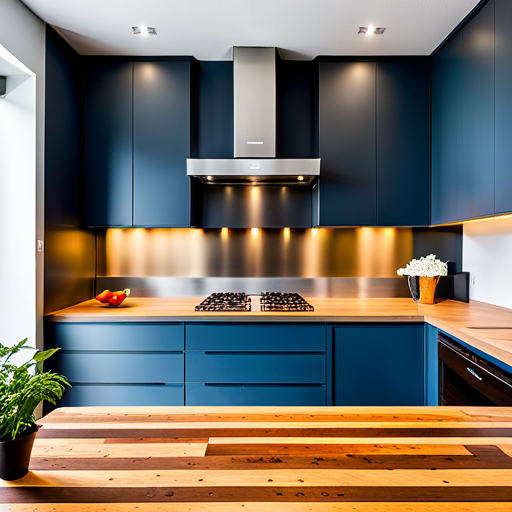
Stainless Steel
Stainless steel backsplashes offer a sleek, modern, and industrial look for your kitchen. They are durable, heat-resistant, and easy to clean. Plus, a stainless steel backsplash pairs well with a variety of kitchen styles and complements the warmth of your butcher block countertop.
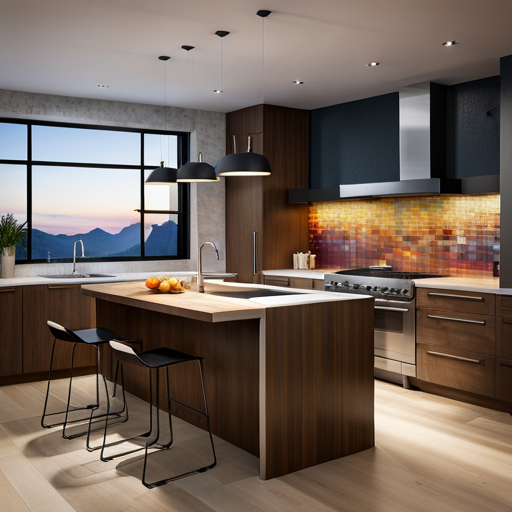
Glass
A glass backsplash can create a clean, contemporary, and airy feel in your kitchen. From solid-colored panels to intricate mosaic designs, glass backsplashes are available in an array of styles. Their reflective surface adds brightness to your kitchen, and they are easy to clean.
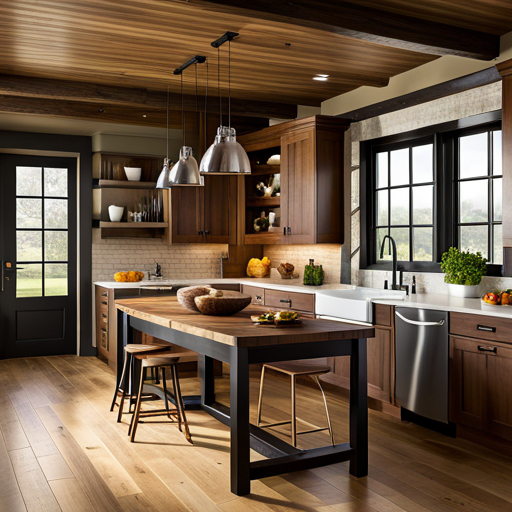
Wood
For a cohesive and warm kitchen design, consider using wood as your backsplash material. Using the same type of wood as your butcher block countertop, such as hickory or walnut, can enhance your kitchen’s overall appearance. However, it’s essential to ensure proper sealing and maintenance to protect the wood from moisture and stains.
Choosing the Right Backsplash
When planning your kitchen design with butcher block countertops, it’s essential to choose the right backsplash that complements the natural beauty of wood while providing a functional and easy-to-maintain surface. In this section, we will discuss three crucial aspects: aesthetic compatibility, functionality, and maintenance and care.
Aesthetic Compatibility
Your backsplash should enhance the overall look of your kitchen. With butcher block countertops, you can explore various materials and styles according to your preferences. For a modern and straightforward feel, consider using white subway tiles as they work well with natural wood tones. If you’re aiming for a rustic appearance, faux brick with gold, tan, and brown shades can create a beautiful contrast. For a unique and bold design, try a Moroccan-inspired tile, as shown in some HGTV designs.
Functionality
While aesthetics are essential, you shouldn’t overlook the functionality of your kitchen backsplash. As it is located behind your countertop and cooktop, it should protect your walls from spills, stains, and grease. To ensure this, opt for materials that are:
- Waterproof, to prevent water damage.
- Durable, to withstand daily wear and tear.
- Resistant to heat, to prevent any damage from hot pots and pans.
Some functional materials to consider include ceramic tiles, stainless steel, and glass tiles.
Maintenance and Care
Your kitchen backsplash should be easy to clean and maintain. Keep in mind that different materials require different maintenance levels:
- Ceramic and porcelain tiles: easy to clean with warm water and mild detergent.
- Glass tiles: can be wiped down with a glass cleaner and soft cloth.
- Stainless steel: requires regular polishing with a stainless steel cleaner to prevent fingerprints and watermarks.
- Natural stone: may need sealing to prevent stains and maintain its appearance.
By considering aesthetic compatibility, functionality, and maintenance and care, you’ll find the perfect backsplash for your butcher block countertops that will enrich your kitchen design and make your cooking experience more enjoyable.
Proper Installation Techniques
When installing a backsplash for your butcher block countertop, it’s essential to follow proper techniques to ensure a long-lasting and attractive result.
Planning and Measuring
Start by planning the layout of your backsplash and taking accurate measurements of the space. Determine the type of materials you will use, and calculate the number of tiles or panels needed based on your measurements. Write down these measurements and consider any unique features or cuts that may be needed for electrical outlets or other obstacles.
Adhesive Selection
Select a suitable adhesive for your chosen backsplash material. For most tile installations, a thin-set mortar or mastic adhesive works effectively. Be sure to choose an adhesive compatible with your countertop and backsplash materials. Read and follow the manufacturer’s instructions to mix and apply the adhesive properly. Use a notched trowel to apply the adhesive evenly to the wall and the back of each tile or panel.
Sealing and Finishing
Once your backsplash is securely adhered, you’ll need to seal and finish the installation. If using tile, apply grout between each tile to fill the gaps and provide a smooth, continuous surface. Choose a grout color that complements your selected tiles and use a grout float to apply it smoothly and efficiently. Wipe away any excess grout with a damp sponge or cloth, and allow it to dry according to the manufacturer’s instructions.
After the grout has dried, apply a sealer to protect it from moisture, stains, and potential damage. This step is particularly important for areas exposed to water, such as behind your sink. Follow the sealer manufacturer’s instructions for proper application and drying times.
By following these techniques, you can feel confident that your backsplash installation will be successful and enhance the beauty of your butcher block countertop.
Benefits and Drawbacks
Pros of a Butcher Block Backsplash
A butcher block backsplash offers you several advantages:
- Aesthetic Appeal: The natural wood look complements various kitchen styles, especially the popular farmhouse and country cottage designs.
- Versatility: Butcher block is available in different wood species and grain patterns, allowing you to customize the appearance according to your preferences.
- Eco-Friendly: As wood is a renewable resource, it minimizes your environmental impact.
- Warmth: The wooden backsplash adds warmth to your kitchen, which is especially inviting in minimalist or contemporary designs.
- Easy to Install: Butcher block backsplashes are typically easier to install than tile or stone alternatives.
Cons of a Butcher Block Backsplash
However, there are also a few drawbacks you should be aware of:
- Maintenance: Wood requires more maintenance than other materials, such as routine sealing and polishing every 2-3 years. This is because wood can absorb oils and liquids which may cause stains.
- Susceptible to Moisture: Wood can warp or become damaged in high humidity or when exposed to water for prolonged periods. To prevent this, make sure to seal the backsplash correctly and address any moisture problems right away.
- Cost: Depending on the type of wood you choose, a butcher block backsplash can be more expensive than some other materials like ceramic tile.
- Limited Resistance: Despite being a robust choice for a countertop, a wooden backsplash may not be as resistant to heat, moisture, and scratches as other materials such as glass or stainless steel.
In summary, a butcher block backsplash offers a warm, versatile, and attractive option for your kitchen, but it also requires more maintenance and care compared to other materials. Make sure to weigh the pros and cons before making your final decision.
Frequently Asked Questions
What type of backsplash complements a butcher block countertop?
A variety of backsplash materials can complement a butcher block countertop. Gray backsplashes are a popular choice for their timeless sophistication and harmonious match with the warmth of wood source. Additionally, materials like ceramic, porcelain, and natural stone tiles can work well in different colors and patterns to suit your personal style.
How do I choose the right tile for a butcher block countertop?
To choose the right tile for your butcher block countertop, consider elements such as overall kitchen design, color scheme, and material preferences. Look for a backsplash that complements the hues and patterns in your countertop and cabinetry. It’s also important to consider the size and shapes of tiles for visual balance in your kitchen.
Can you use a wood backsplash with a butcher block counter?
Yes, you can use a wood backsplash with a butcher block counter. There are peel-and-stick options that provide a faux wood finish, which is waterproof and removable source. However, ensure it does not overwhelm your kitchen design and that it complements the other elements in your kitchen space.
Are there any specific installation tips for backsplash with a butcher block countertop?
When installing a backsplash with a butcher block countertop, it is crucial to ensure a tight, seamless fit between the backsplash and countertop to prevent water damage. Use a silicon sealant or construction adhesive to secure the backsplash in place and create a strong bond between the materials. Measure and cut the backsplash accurately to fit your space, and consult a professional if needed.
What materials should be avoided for a backsplash with a butcher block counter?
Avoid materials that absorb moisture and stains easily, as they may not hold up well near a butcher block countertop where water and food contact is frequent. It is also wise to avoid excessive use of heavy, dark materials that may overwhelm the warmth of the butcher block countertop and make the space feel closed or cramped.
How do I maintain the backsplash and butcher block countertop for durability?
To maintain your backsplash and butcher block countertop, clean the surfaces regularly with gentle, non-abrasive cleaners. For butcher block countertops, consider applying a food-safe mineral oil or beeswax to protect and maintain the surface. Inspect the areas where the backsplash meets the countertop for any signs of moisture or damage, and address them promptly to keep your butcher block and backsplash in good condition.
Next Steps
Want to join others who are creating the most amazing home redesigns & renovations and get more tips, tricks and hacks on how to make your home the best it can be?
Join my brand new free private Facebook group, Remodel Reality to connect with other people like you to make your space the best!
